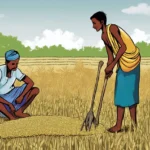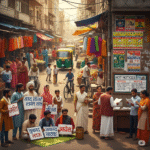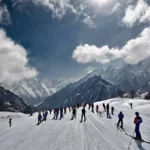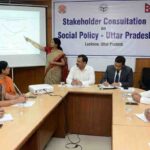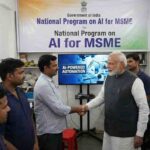Lucknow, 2025 — Uttar Pradesh (UP), a political behemoth in India due to its massive electorate and strategic significance, doesn’t just shape its own destiny; its political currents also profoundly impact neighboring states like Bihar, Madhya Pradesh, Uttarakhand, and even Delhi. This article explores the ripple effects of UP’s political dynamics on these regions, illustrating how electoral trends, policy decisions, and political strategies in UP set precedents and influence broader regional politics.
Influence on Electoral Strategies
- Campaign Tactics
- Spillover: The methods and tactics successful in UP, such as caste-based mobilization or religious appeals, are often adopted by neighboring states to galvanize similar demographics.
- Example: Bihar, with its similarly complex caste dynamics, frequently mirrors UP’s electoral strategies to engage voters.
- Policy Initiatives
- Test Bed: Given its size and diversity, policies piloted in UP, such as agricultural reforms or urban development initiatives, provide a template for neighboring regions.
- Adoption: States like Madhya Pradesh and Uttarakhand often implement successful UP policies, especially those related to rural development and social welfare.
Economic and Social Policies
- Migration Patterns
- Labor Movement: UP’s economic policies significantly affect migration patterns, with labor flows impacting economies in Delhi and neighboring states.
- Impact: Changes in UP’s job market or agricultural sector can lead to shifts in migrant labor trends, affecting demographics and local economies in adjacent areas.
- Infrastructure Development
- Connectivity Projects: Major projects like expressways and railways that begin in UP often extend into neighboring states, influencing their economic landscapes.
- Example: The Purvanchal Expressway enhances connectivity not just within UP but also improves access to Bihar, facilitating economic integration.
Cultural and Social Influence
- Communal Harmony and Tensions
- Harmony Initiatives: Efforts to promote communal harmony in UP can serve as models for neighboring states grappling with similar issues.
- Spread of Communalism: Conversely, communal tensions can transcend state borders, influencing social dynamics in regions like Delhi and Uttarakhand.
- Educational and Health Policies
- Policy Modeling: UP’s reforms in health and education sectors often inspire similar reforms in adjacent states looking to replicate UP’s successes or learn from its challenges.
- Collaborative Programs: Cross-border health and education initiatives can arise, especially in regions close to UP’s borders, to address shared challenges.
Political Alliances and Rivalries
- Coalition Dynamics
- Formation and Dissolution: Political alliances formed in UP elections often set precedents for coalition politics in neighboring states.
- Strategy Alignment: Parties may align their strategies across state lines to present a unified front in regional politics.
- Inter-State Relations
- Collaborative Governance: UP’s relationships with neighboring state governments can influence cooperative projects and joint initiatives, especially in areas like water resource management and environmental conservation.
- Political Friction: Disputes between UP and its neighbors over resources or policy differences can also affect broader regional stability.
Conclusion: A Pervasive Influence
Uttar Pradesh’s political landscape is a formidable force with the capacity to influence not only its own electoral and policy outcomes but also those of neighboring states. The strategies, policies, and political climate in UP often create waves that ripple through the surrounding regions, shaping their political, economic, and social fabric. Understanding these dynamics is crucial for political analysts, policymakers, and parties operating in North India, as they navigate the interconnected terrain of regional politics.



